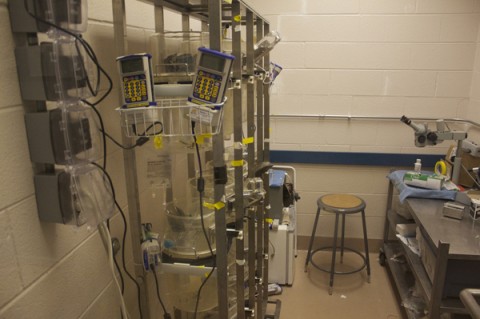Animal Underground
The Unit for Laboratory Animal Medicine and its relation to the hospital at large.
Like ULAM and its relation to the hospital, the modern healthcare system is a tangle of contradictions, glossed over with a reassuring veneer. Between the blissful logic of cardiac physiology, the static views of descending and ascending tubules in histological slides, and the coldly logical tangle of biochemical pathways, health and disease are made to be clean and clearly delineated realms of knowledge. This image is also the face of the medical field to the laity. Flip on the TV and without fail a barrage of ads reassure viewers that no matter what problem they’ve got, there’s a pill for it. A cursory glance at the health section of any newspaper will undoubtedly turn up an article about the latest breakthrough in the search for a cure for some disease, the announcement of a benevolent disbursement of aid to some destitute country, or some other reminder of medicine’s constant march of progress. The very architecture of the modern hospital as a titanic fortress where the scourge of disease is combated is, in a way, a monument to the field’s continued great leaps forward.
Yet this is but the more facile face. Many a lecturer has let slip (not without a strange tincture of glee) the clichéd disclaimer “Half of the stuff I was taught in medical school turned out to be wrong, and probably half the stuff I’m about to tell you about is wrong too.” Television ads peddling the latest prescriptions invariably downplay their unseemly side effects; what is more, they depress the market for generic drugs by goading people into believing that their newfangled formulas are superior to older, yet still satisfactorily efficacious pills. As for all those announcements of scientific breakthroughs, still is medicine woefully impotent in treating and preventing many diseases. While articles laud generous gifts of aid, rarely mentioned is the fact that rather innocuous illnesses and procedures whose treatment and risks in developed countries are exceedingly pedestrian still kill at an appallingly higher rate in less wealthy nations. Infant and maternal mortality rates, as just one example, are astronomically higher in Sub-Saharan Africa than Western Europe. Finally, for all the intended reassurances the modern hospital seeks to convey, blotted is its escutcheon by the embarrassing fact that nosocomial infections, medical errors, and astronomical costs make it a sometimes dangerous and unnecessarily luxurious place to be.
***
Medicine, like all social constructs, is a product of history. With its development have come innumerable boons to society; yet also bound up in its substance are the less-kosher accretions of years past. Gavin and Kristy’s work at ULAM is burdened with similar cumbersome vestiges of past policies. “When you move up through a static system,” said Gavin on this topic, “you tend to adopt its ideology. I don’t want to do that… I want to change things for the better.” Turning a critical eye to the environs of the hospital, to medicine at large, is one way that we too can guard against complacency in order ensure the field’s lofty goals are reached.


Hi There: I really enjoyed your article. My son is also a tech at the U of M. He and I have faced criticism many times when people discover what his job entails. They could not be more wrong.
My son has always had love forand an almost supernatural connection with animals. He brought home EVERY stray he encountered when he was younger.
I am extremely proud of my son and wholeheartedly support him and his profession and others in his field. Thank you for writing this paper. It was very well put together.
All the best,
Linda Wold
Kudos to you! I hadn’t thgouht of that!